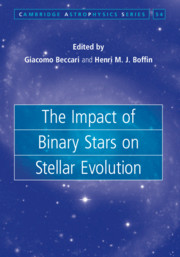Book contents
- Frontmatter
- Contents
- List of Contributors
- Foreword
- Introduction
- 1 The Zoo of Binary Stars
- 2 Statistics of Binary and Multiple Stars
- 3 Gaia and LSST: Their Importance in Binary Star Research
- 4 Population Synthesis of Binary Stars
- 5 Low- and Intermediate-Mass Star Evolution: Open Problems
- 6 The Symbiotic Stars
- 7 Binary Post-AGB Stars as Tracers of Stellar Evolution
- 8 The Importance of Binarity in the Formation and Evolution of Planetary Nebulae
- 9 Massive Star Evolution: Binaries as Two Single Stars
- 10 Binarity at High Masses
- 11 Luminous Blue Variables: Their Formation and Instability in the Context of Binary Interactions
- 12 Type Ia Supernovae: Where Are They Coming From and Where Will They Lead Us?
- 13 Binary Interactions and Gamma-Ray Bursts
- 14 Binaries as Sources of Gravitational Waves
- 15 The Impact of Binaries on the Stellar Initial Mass Function
- 16 The Formation of Binary Stars: Insights from Theory and Observation
- 17 The Maxwell’s Demon of Star Clusters
- 18 Alternative Stellar Evolution Pathways
- 19 Clocks and Scales: Playing with the Physics of Blue Stragglers
- 20 Binaries at Very Low Metallicity
- 21 Population and Spectral Synthesis: It Doesn’t Work without Binaries
- Index
1 - The Zoo of Binary Stars
Published online by Cambridge University Press: 05 April 2019
- Frontmatter
- Contents
- List of Contributors
- Foreword
- Introduction
- 1 The Zoo of Binary Stars
- 2 Statistics of Binary and Multiple Stars
- 3 Gaia and LSST: Their Importance in Binary Star Research
- 4 Population Synthesis of Binary Stars
- 5 Low- and Intermediate-Mass Star Evolution: Open Problems
- 6 The Symbiotic Stars
- 7 Binary Post-AGB Stars as Tracers of Stellar Evolution
- 8 The Importance of Binarity in the Formation and Evolution of Planetary Nebulae
- 9 Massive Star Evolution: Binaries as Two Single Stars
- 10 Binarity at High Masses
- 11 Luminous Blue Variables: Their Formation and Instability in the Context of Binary Interactions
- 12 Type Ia Supernovae: Where Are They Coming From and Where Will They Lead Us?
- 13 Binary Interactions and Gamma-Ray Bursts
- 14 Binaries as Sources of Gravitational Waves
- 15 The Impact of Binaries on the Stellar Initial Mass Function
- 16 The Formation of Binary Stars: Insights from Theory and Observation
- 17 The Maxwell’s Demon of Star Clusters
- 18 Alternative Stellar Evolution Pathways
- 19 Clocks and Scales: Playing with the Physics of Blue Stragglers
- 20 Binaries at Very Low Metallicity
- 21 Population and Spectral Synthesis: It Doesn’t Work without Binaries
- Index
Summary
Stars are mostly found in binary and multiple systems, as at least 50% of all solarlike stars have companions – a fraction that goes up to 100% for the most massive stars. Moreover, a large fraction of them will interact in some way or another: at least half of the binary systems containing solarlike stars, in particular when the primary will evolve on the Asymptotic Giant Branch and at least 70% of all massive stars. Such interactions can, and often will, alter the structure and evolution of both components in the system. This will, in turn, lead to the production of exotic objects whose existence cannot be explained by standard stellar evolution models. Moreover, the chapter explores one of the most luminous stars in our Galaxy, Eta Carinae. The year 2016 saw the first ever announcement of the detection of gravitational waves, coming from the merging of a binary black hole. In this chapter, the author leads the reader through a walk in the zoo of binary stars, highlighting some specific examples.
Information
- Type
- Chapter
- Information
- The Impact of Binary Stars on Stellar Evolution , pp. 1 - 11Publisher: Cambridge University PressPrint publication year: 2019
